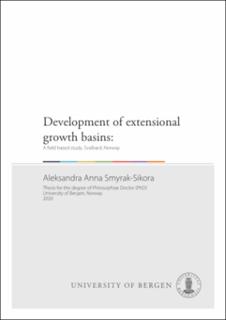| dc.contributor.author | Smyrak-Sikora, Aleksandra Anna | |
| dc.date.accessioned | 2020-03-13T14:14:01Z | |
| dc.date.available | 2020-03-13T14:14:01Z | |
| dc.date.issued | 2020-02-27 | |
| dc.date.submitted | 2020-02-05T15:09:00.069Z | |
| dc.identifier | container/8d/fe/80/2a/8dfe802a-4a74-4cfa-8ce4-7377978d3c7d | |
| dc.identifier.uri | https://hdl.handle.net/1956/21496 | |
| dc.description.abstract | The growth style and evolution of syn-sedimentary faults influence the architecture of the basin and thus control both the geometries and distribution of sedimentary facies belts. The architecture of sedimentary basin fill reflects a combination of tectonic and climatic controls that are relatively unique for each geological setting. This statement was tested in Svalbard, Norway, where recent post-glacial topography and a lack of vegetation reveal unique outcrops that allow detailed investigation of spatio-temporal basin fill development. Field studies were conducted in two locations: in the Upper Carboniferous Billefjorden Trough outcropping in central Spitsbergen, and in Kvalpynten, Edgeøya, wherean array Upper Triassic growth faults is exposed. This body of work consists of four scientific articles. Field-based results from detailed sedimentological logging, structural measurements and geological mapping were combined with analysis of three-dimensional outcrop models (derived from LIDAR scans and photogrammetry). Published data such as lithostratigraphy from the boreholes and sedimentary logs were also integrated to form an extensive and coherent database. A ca. 25 km wide basin fill of the Billefjorden Trough records the transition from a continental to a paralic sedimentary facies that formed in response to the opening of a connection to the sea. Early syn-rift deposition occurred in a basin segmented into the hanging wall blocks of meso-scale (tens to hundred meters of displacement) growth faults, in partly isolated sub-basins. In this phase the Billefjorden Trough was a symmetrical basin. Later on, half-graben geometry developed during the rift climax, highlighted by deposition of up to 400 meters of alluvial fan deposits confined to the master fault zone. Meso-scale faults have segmented the dipslope into proximal and distal part. The tectonic impact on the basin fill was the greatest near the master fault zone and in the proximal dipslope. The imprint of eustatic sea level prevails over the 13 tectonic influence in the distal dipslope. Rift reorganization and narrowing phase redefine the basin configuration, which is less asymmetric than in the rift climax and subsides more slowly. Growth fault displacement maxima define zones on the footwall blocks, with evaporite dissolution and formation of stratiform breccias. A narrow, centrally located depocenter on the hanging wall block formed between two antithetic faults, was protected against dissolution and contains thick beds of evaporites. The world- class growth faults in Kvalpynten bound twelve ca. 250-800 m wide basins filled with prodelta to lower delta front mudstones and shales. The basin fills consist of tens of meters thick, coarsening upward units, where the sandy parts represent tidal dunes and bars detached from the delta front deposits. Faults have developed due to differential compaction of the water-saturated, underlying organic-rich mudstones and the prodelta mudstones. The sediments were deposited on the structural slope dipping against the direction of prograding delta system. The structural control is reflected in syn-kinematic, late syn-kinematic and post-kinematic accommodation that in combination with relative sea level controlled the type and stacking patterns of the architectural elements filling the basins. Combined results from the tectonically-driven development of the Billefjorden rift and differential compaction-driven Kvalpynten growth faults allow discussion of the similarities and differences that result from, among other things, the driving mechanisms of faulting, the size and the type of basin fill (i.e. siliciclastic vs. mixed but -carbonate-evaporite dominated deposits). Despite the diverse scale, the extensional systems developed in both locations display similar evolution of a half-graben geometry that is pre-dated by symmetrical graben. | en_US |
| dc.language.iso | eng | eng |
| dc.publisher | The University of Bergen | en_US |
| dc.relation.haspart | Article 1: Smyrak-Sikora, A., Johannessen E. P., Olaussen S., Sandal, G. & Braathen, A. (2018): “Sedimentary architecture during Carboniferous rift initiation - the arid Billefjorden Trough, Svalbard”, Journal of the Geological Society, 176(2), 225-252. The article is not available in BORA due to publisher restrictions. The published version is available at: <a href="https://doi.org/10.1144/jgs2018-100" target="blank">https://doi.org/10.1144/jgs2018-100</a> | en_US |
| dc.relation.haspart | Article 2: Smyrak-Sikora, A., Nicolaisen J. B., Braathen A., Johannessen E. P., Olaussen S. & Stemmerik, L. (2020): “Impact of dipslope growth faults on mixed carbonateevaporite dominated deposits – Carboniferous Billefjorden Trough in Svalbard, Norway“. The article is not available in BORA. | en_US |
| dc.relation.haspart | Article 3: Smyrak-Sikora, A., Osmundsen, P. T., Braathen, A., Ogata, K., Anell, I., Mulrooney, M. & Zuchuat, V. (2020): “Architecture of growth basins in a tidally-influenced, prodelta to delta-front setting: the Triassic succession of Kvalpynten, East Svalbard”, Basin Research, 32(5), 949-978. The article is available at: <a href="http://hdl.handle.net/1956/21494" target="blank">http://hdl.handle.net/1956/21494</a> | en_US |
| dc.relation.haspart | Article 4: Ogata, K., Mulrooney, M. J., Braathen, A., Maher, H., Osmundsen, P. T., Anell, I., Smyrak-Sikora, A. & Balsamo, F. (2018): “Architecture, deformation style and petrophysical properties of growth fault systems: the Late Triassic deltaic succession of southern Edgeøya (East Svalbard) “, Basin Research, 30(5), 1042-1073. The article is available at: <a href="http://hdl.handle.net/1956/19698" target="blank">http://hdl.handle.net/1956/19698</a> | en_US |
| dc.rights | In copyright | eng |
| dc.rights.uri | http://rightsstatements.org/page/InC/1.0/ | eng |
| dc.title | Development of extensional growth basins: A field based study, Svalbard, Norway | en_US |
| dc.type | Doctoral thesis | |
| dc.date.updated | 2020-02-05T15:09:00.069Z | |
| dc.rights.holder | Copyright the Author. All rights reserved | en_US |
| dc.contributor.orcid | https://orcid.org/0000-0001-9321-1269 | |
| fs.unitcode | 12-50-0 | |
